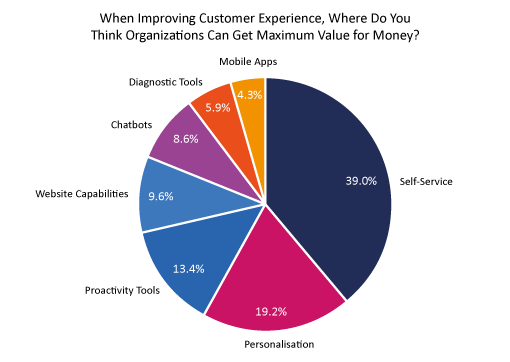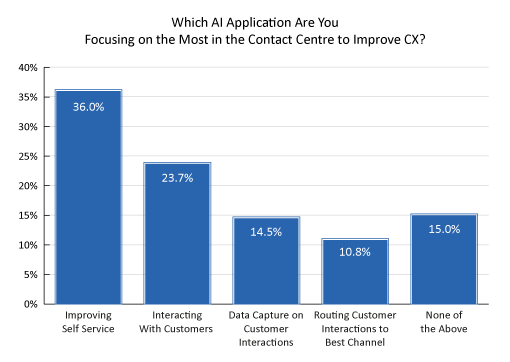Our consultants panel share their thoughts on the latest trends in CX self-service.
Customers Are Less and Less Tolerant of Failed Self-Service Attempts

I have come to the realization that customers are less and less tolerant of failed self-service attempts – and when they want to speak with a human, they REALLY want to speak with a human NOW.
As more and more people isolate themselves into the post-pandemic, virtual world of social media, the backlash when they can’t quickly solve their issues increases in severity.
These situations are relatively easy to defuse with a caring and competent human connection, but they require more patience and emotional intelligence from contact centre agents than ever before.
As a result, contact centres should be continuing to improve self-service, while also making it easier for them to connect with a human when they need to. The humans aren’t going away any time soon!
Contributed by: Jeremy Watkin, Director of Customer Experience and Support at NumberBarn
Videos Are Being Used as a Means to Help Customers Educate Themselves
Taking self-service innovator Tesla as an example, all research, purchase, delivery, and service processes are online. They are comprehensive and the choices are very limited, hence simple. There is easy access to chat and phone before ordering.
You can also book and go in and self-test drive yourself – with no driver accompaniment. Not only that, but there’s extensive use of video and self-help mechanisms to educate yourself.
We Still Need Back Up for When Self-Service Doesn’t Work

Continuing with my Tesla experience, when you have ordered, you get a welcome call and a person who handles any questions to keep you working through the order and payment processes in the app.
Then you pick up the car. At which point you can literally go “talk to the hand”! The car has a scratch on it. The app won’t connect to the car. “I can’t do anything about that. You need to report it in the app.”
There is no delivery problem area in the service app. In fact, over the next few weeks, they try to communicate through the app, which isn’t useful when the app doesn’t work properly.
You can message service within the app, but you cannot talk to service. You cannot escalate it – I tried. All you can do is book an appointment and travel all the way back to the service depot.
You can’t find out how long it will take. The app changes the date. Utter frustration, although I see they have now published service numbers for the depots in the last few days.
Eventually you go to an appointment, the car cleverly checks itself in through the geofence, allocating itself to an engineer and giving him pin access.
The people are great, the paint gets fixed. They start trying to understand the app problem. They tell you lots of people have problems with delivery issues and with communicating through the app.
The moral of the story? Designing an innovative new customer journey is great when it works… Back-up is required for when it doesn’t!
Rigorous Design Rules Underline Success
By contrast, my experience with the DVLA of changing the number plate over was a piece of cake online. Reporting a dangerous failure to the DVSA – full marks for self-service.
Government websites use rigorous design rules for presentation and testing of self-service. They’re excellent and are free to copy.
Contributed by: Peter Massey, MD & co-founder at Budd UK Ltd
Contact Centres Need to Incentivize Customers to Use Self-Service Options

The State of Customer Service and CX: The 2023 ACA Study, a survey of over 1,000 American consumers sponsored by Five9, recently asked ‘When you have a problem or issue with a company or brand, which solution do you prefer to help solve your problem (phone or digital self-service)?’
As of 2023, there was a 69% / 31% split between ‘Call the company and talk to a live customer service agent’ and ‘Use a digital self-service option’ in favour of calling the company. Interestingly, the preference for self-service dropped to 18% for Boomers and increased to 48% for Gen Z.
This highlights that there’s a big educational piece to do here, and that contact centres must embrace the challenge of training their customers to use their digital solutions to succeed.
Some industry players are already rising to the challenge! A great example of this is how, a few years ago, a well-known airline incentivized customers to try their online, self-service booking.
If you would give it a go, they would reward you with 500 extra miles on your account – with the safety net that they could pick up the phone straight away if they wanted to.
So what happened? With the incentive, many customers tried it AND found it was easy, intuitive, and pretty quick to do, leading to a marked shift in customer behaviour moving forward (and efficiency savings for the airline!).
Contributed by: Shep Hyken, Chief Amazement Officer (CAO) at Shepard Presentations LLC
Personalization Is Enhancing Self-Service

Personalization is all about tailoring the experience to your customer’s preferences and habits. Each of your customers is unique and prefers a different style of self-service.
Many self-service platforms are powered by AI technologies that can deliver highly personalized feedback for customers instead of generic advice that leaves them with unanswered questions.
With the ability to instantly pull order confirmations and details, chatbots can efficiently address individual concerns and put solutions into action.
Ultimately, personalization enhances the overall self-service experience by meeting customers where they are and creating convenient and relevant interactions.
Contributed by: Brittany Hodak, Keynote Speaker & Author of Creating Superfans
Some Contact Centres Are Starting to Cap Agent Headcount in Favour of AI

Artificial intelligence (AI) is making a difference to self-service in many contact centres.
For instance, some contact centres are capping headcount, hoping an AI-driven productivity boost will allow them to handle higher contact volumes without increasing staff – such as handling an increasing percentage of customer enquiries via chatbots.
Contributed by: Mike Aoki, President, Reflective Keynotes Inc.
Self-Service Perceived as Great Value for Money Too
The latest Call Centre Helper research revealed that more than a third (39%) of survey respondents stated that investing in self-service was where they believed their organization could see maximum value for money.

Not only this, but when asked ‘Which AI application are you focusing on the most in the contact centre to improve CX?’, improving self-service took a clear lead at 36%.

Generative AI-Powered Chatbots Can Solve Niche Issues – Fast!
Chatbots infused with generative AI capabilities are making great strides in self-service.
Not only can they now deal with very poor communication skills and multiple languages, but there’s also potential for the technology to solve really niche issues.
For example, chatbots are being built with data sets relating to car manuals for particular makes and models of car, so they can now quickly answer very niche questions with accuracy – saving time for a customer who might otherwise have to look through a manual themselves, or wait for an agent to find the specific detail they need for their make and model of car.
Not only this, but when the chatbot serves up that information, the customer can also query how easy it is to understand and ask it to explain it to them again as if they were 10 years old or ask if it could translate the answer to Spanish (for example) for a non-English-speaking family member. Far beyond the capabilities of most humans.
Contributed by: Shep Hyken, Chief Amazement Officer (CAO) at Shepard Presentations LLC
Brands Are Expanding Their Self-Service Options
To adapt to today’s evolving landscape, brands are expanding their self-service options, including concise videos, dynamic guidebooks, voice-activated conversations, searchable knowledge bases, and augmented reality.
Brands like American Airlines automatically integrate chat conversations into Apple’s iMessage app, eliminating the need to keep a certain browser window open on your phone for several minutes at a time.
Even days after your conversation ended, you can refer back to your conversations like real text threads and ask another question.
This will prompt American Airlines to assign you a new agent without having to go back on their website to get in touch.
When companies offer a wide range of services, they’re showing their customers that they acknowledge their diverse needs and lifestyles, respect their time, and value them as individuals.
Contributed by: Brittany Hodak, Keynote Speaker & Author of Creating Superfans
Self-Service Is Having a Knock-On Effect on Human-to-Human AHT
If you want to scale back on human to human, be very careful!
A study I did recently asked ‘Has AI allowed you to reduce your staff and customer support?’ Only 9% said yes, whilst 63% said they were still increasing their staff.
This confirms that, even with all of the digital opportunity, we still need humans, and there’s a couple of reasons why:
- No matter how good the digital experience, it’s still not as strong at building relationships with each other.
- Average Handle Time (AHT) is going up, not down, because of the complexity of the issues agents are now handling – whilst self-service picks up the easier queries.
Contributed by: Shep Hyken, Chief Amazement Officer (CAO) at Shepard Presentations LLC
A Final Word on Self-Service
You should never rest on your laurels when it comes to self-service improvements, as Peter Massey comments:
“I look at self-service through the lens of a two-by-two contact matrix you’ll have seen me write about many times – the ‘Value Irritant’ matrix.
- Value OR irritant to the customer
- Value OR irritant to the company
Self-service works well when there is value to the customer and irritant to the company. Value to both parties is where a person-to-person conversation should be available.
Irritant to both and it should not be happening. Irritant to customer and value to company means ‘I won’t work through your self-service, you need to simplify things’.
In addition, your analytics and feedback loops should be continuously telling you how to improve the ability of your customers to self-serve – and you should be continuously improving!”
We have got some more great articles from the experts that you should read next:
- 29 Ways to Transform Your Call Centre Staff Surveys
- How to Manage Big Changes Well in the Contact Centre
- Bottom Quartile Management – How to Boost Your Lowest Performers
- 25 Ways to Proactively Spot Your Customers’ Pain Points
Author: Megan Jones
Reviewed by: Xander Freeman
Published On: 1st Nov 2023 - Last modified: 22nd Oct 2025
Read more about - Customer Service Strategy, Brittany Hodak, Chatbots, Customer Engagement, Customer Experience (CX), Customer Service, Editor's Picks, Jeremy Watkin, Mike Aoki, Peter Massey, Self Service, Service Strategy, Shep Hyken, Trends










































